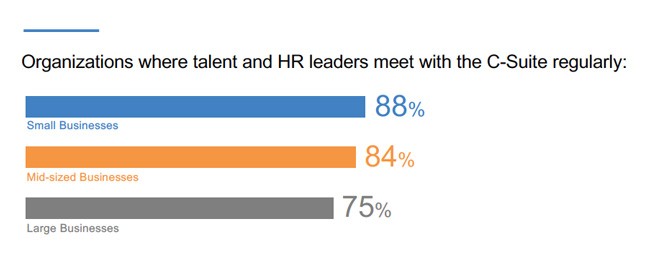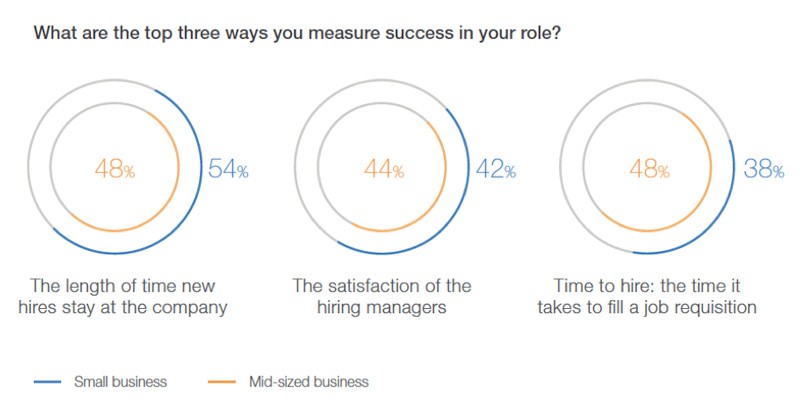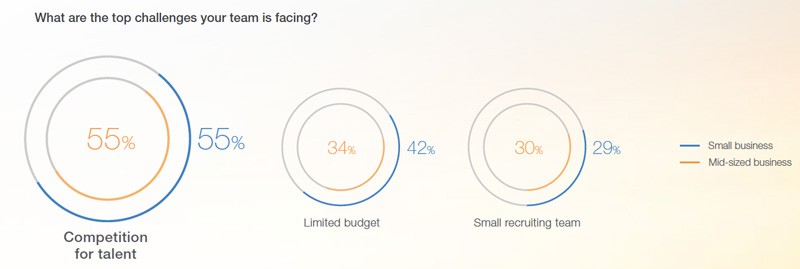3 Insights Small Business Recruiters Should Share to Get C-Suite Support
In our 2017 Small to Mid-Sized Business Recruiting Trends report, 53% of talent leaders reported that they expect their recruiting budget to stay the same next year. At the same time, 57% of them say that their hiring volume will increase. In other words, SMB recruiters work loads will increase, but their resources will not (a trend we are seeing at larger companies as well).
But, there's good news: our report also revealed that talent leaders at SMBs meet with the C-Suite regularly - more regularly than their larger peers at larger companes:

In order to get and maintain exec buy-in, here are three things you should be covering with your C-Suite on a regular basis:
1. Where your recruiting success metrics stand and what you need to improve
In our report, we asked talent leaders at SMBs their key success metrics. While the top three KPIs were the same for companies of all sizes, the prioritization varies:
Employee turnover is extremely costly for SMBs, which is why talent and HR leaders primarily measure success by how long new hires stay at the company. Hiring manager satisfaction is also a way to measure quality of hire, which is very important for small businesses where a bad apple can make a company's success. While hiring manager satisfaction is important to mid-sized businesses, they focused on growing and need to close open reqs more quickly.
Regardless, SMBs hire talent faster than larger businesses -- it’s rare for the process to take longer than 2 months. This is where fast and lean teams have a competitive edge over larger, process-filled organizations.
So what does this mean for you? Track these three metrics regularly, and be sure to report them to your exec staff. That way, there won't be any surprises as they have constant visibility into the progress being made and can help identify and resolve challenges.
2. Data on the competitative landscape for the talent you need
Differentiating from the competition is the #1 recruiting challenge for SMBs. Even more so when the highest priority roles to fill -- sales, operations, business development and engineering – are also the highest in demand.
It’s hard for SMBs to compete when recruiting teams are strapped for resources, and the C-Suite doesn’t have visibility into the talent market. No doubt your boss is numbers-hungry, so use data to get more resources and approval on hiring initiatives that have the biggest impact.
For example, when recruiting for high priority roles, use talent pools and industry reports to pinpoint locations where the supply of talent is higher than the demand. This will not only set clear expectations with your C-suite, but also give them visibility into the potential hires that will move your business forward. You can also present talent trends which shed light onto what candidates are looking for in a potential employer and how they go about their job search.
Another successful tactic is targeting each of these highest priority job functions with highly customized employer branding content. And speaking of employer branding…
3. The impact of good employer branding and where your peers are investing
77% of talent acquisition managers at SMBs agree that their employer brand has a significant impact on their ability to hire great talent. So after showing your C-Suite the data and insights into the growing competition, try asking for more budget for employer branding to help get a leg up over competitors.
If you don’t get the blessing for more recruiting budget, explain how you need to use it differently to compete for great talent. Show the breakdown of what you currently use your budget on, and where you’d like to invest if you had more freedom (in dollars and spending). For example, pull a small amount from one area to do a small test in employer branding. Ask to partner with marketing to share joint ownership of the website, social media channels and content production. Most SMBs have 1 – 5 people managing their employer brand.
Don’t forget to show what your peers are thinking, and how you need to invest similarly to stay ahead of the competition:
If you’re looking for more industry insights to share with your exec staff, check out the 2017 Small and Mid-Sized Business Recruiting Trends report, which is filled with what’s top of mind for your peers.
To receive blog posts like this one straight in your inbox, subscribe to the blog newsletter.
Topics: Small business Data insights
Related articles





